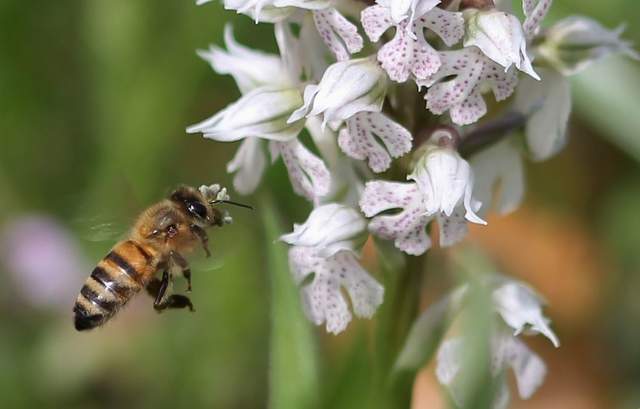Orchids can be propagated through various means, one of which is by pollination. Though it is the most tedious method of propagation, still the orchids produced through this method are more capable of fighting diseases and are more diverse.
Pollination in orchid flowers happens by two methods: natural pollinators or manually (by us). Orchid hybrids are produced through manual pollination method. Parents with desired features are selected to produce hybrid orchids. Though, this method is not hundred per cent accurate but with practice the accuracy increases.
Insects such as bees, wasps, flies, butterflies, moths, beetles as well as birds and even mosquitoes are natural orchid pollinators. Out of these, wasps and bees are the major pollinators of orchids pollinating nearly 60% of the orchids. The shape, size, colour, fragrance etc. of the orchid flower decides which pollinator will come to pollinate. For example, gullet - type (bowl-shaped) flowers get pollinated mostly by bees. Shallow cupped flowers are mostly pollinated by flies. Tubular and vividly coloured flowers are visited by birds, like the tiny sunbirds, hummingbirds.
Thumb-rule : The size of the flower is generally proportionate to the size of the pollinator i.e. smaller the flower, smaller will be the pollinator. We see this in large Cymbidium flowers that get pollinated by large carpenter bees. Bees and wasps cannot see red colour, so except this colour, wasp/bee-pollinated flowers show a wide range of colour; whereas birds mostly pollinate brightly coloured flowers. Orchids even time their production of scent according to the availability of the pollinator, as seen in case of moth-pollinated flowers.
If your orchid flowers are not getting pollinated, then it could be that the pollinators cannot find your orchid. This happens when orchids are shifted out of their native places; they then take time to adapt to a new set of pollinators. You can try pollinating flowers yourself or you can try attracting the local pollinators. Do research and find out the natural pollinators of that orchid, then you can attract similar pollinators. Attracting pollinators can be aided by planting other groups of insect/birds attracting-plants in the neighbourhood of orchids.
Flowers such as sunflowers attract bees; birds can be attracted by hibiscus or other such flowers. Moths and butterflies are attracted by scent and nectar-producing flowers. Moths seem to prefer white coloured flowerse.g honeysuckle, white impatiens. You can also check out with your local nurseries for plants that attract different insects.
Note: Please avoid pesticides; it kills even the good insects, like the ladybugs. We have mosquito invasion in summers and the local administration sprays pesticides to kill these. Sadly, after one such spraying, I noticed many dead ladybugs the next morning. Now I take other measures to counter mosquitoes.
Resources
1. Ron Mchatton,2011. Orchid Pollination: Exploring a fascinating world. Orchids: 338 - 349.
 Bee pollinating an Orchis lactea photographed near Toulouse (France).
Photography credit: Gilles SALAMA
Bee pollinating an Orchis lactea photographed near Toulouse (France).
Photography credit: Gilles SALAMA
Pollinating The Orchid Flowers
Curiosityby Anu Dharmani
Originally published in BellaOnline
Posted by Sys Admin over 7 years ago.Article Blog Article Index
Share on Social Media:
New Topics
- David George asked question Odom's Fascination - an unusual orchid in category General Discussion
- Carol Holdren asked question Grow Tent in the Garage in category General Discussion
- David George asked question rlc Caotan Beauty found at Home Depot in category Cattleya Alliance
- Kristin Dorris asked question Odontocidium Orchid fungus? in category General Discussion
- Maria Fernandez asked question Wild. Lisa Devos in category Dendrobiums
New Comments
- Carol Holdren commented on topic "rlc Caotan Beauty found at Home Depot " by David George
- Carol Holdren commented on topic "Odom's Fascination - an unusual orchid" by David George
- Dr. Florian Wolf commented on topic "Wild. Lisa Devos" by Maria Fernandez
- Michael Valcarcel commented on member plant Rlc. Chief Takanaka by Walceli Muniz Valverde
- Michael Valcarcel commented on member plant Rlc. Montana Spirit by Michael Valcarcel
- Michael Valcarcel commented on member plant Ctt. Blazing Sun by Michael Valcarcel
- Michael Valcarcel commented on member plant Bc. Spotted Clown by Michael Valcarcel
- Maria Skrypnyk commented on member plant Yamadara Redland Sunset by Maria Skrypnyk
- André Pessina commented on topic "Odontocidium Orchid fungus?" by Kristin Dorris
- Linda Hartman commented on topic "Image of a plant please" by Leshya Perkins
- Paul Reavis commented on orchid Milt. Kismet
- Christiaan Viljoen commented on member plant Psh. fragrans by Christiaan Viljoen
- Christiaan Viljoen commented on member plant Z. maculatum by Christiaan Viljoen
- Christiaan Viljoen commented on member plant C. Gaskell-Pumila 'Azure Star' by Christiaan Viljoen
- Robert H. Findlay commented on member plant Rlc. Joy Sokabe var. Volcano Queen by Sally K
- James Lunsford commented on member plant Lc. Sagarik Wax 'African Beauty AMO/AOS x Blc. Cherry Suisse'Kauai' HCC/AOS var. Cattlyea 'Hybrid ' by James Lunsford
- John Varigos commented on orchid Bulb. schwarzii
- Linda Hartman commented on topic "Issue with Blc. Ben O'Neil "Jubilee" by Glenda Ratliff
- Henry Shaw commented on member plant Ons. Catatante 'Los Roble' by Henry Shaw
- Mary Lane commented on member plant Den. Tianmu Canary by Terre Moore